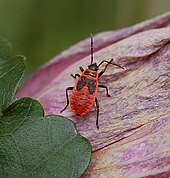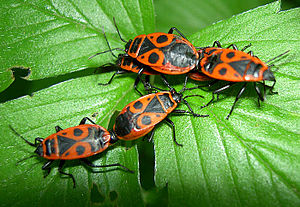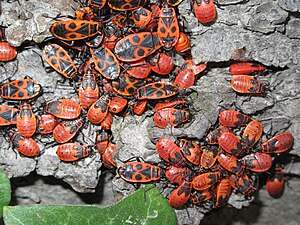Common fire bug
| Common fire bug | ||||||||||
|---|---|---|---|---|---|---|---|---|---|---|

Common fire bug ( Pyrrhocoris apterus ) |
||||||||||
| Systematics | ||||||||||
|
||||||||||
| Scientific name | ||||||||||
| Pyrrhocoris apterus | ||||||||||
| ( Linnaeus , 1758) |
The common fire bug ( Pyrrhocoris apterus ) is a species from the family of fire bugs (Pyrrhocoridae). The species, which is very striking due to its color, is usually simply called a fire bug, but it is also popularly known as a cobbler or fire beetle, i.e. mistakenly mistaken for a beetle . The animals live socially, so that they are often found in large numbers in their preferred biotopes .
features
The common fire bug reaches a body length of 6.5 to 12 millimeters. Their body outline is oval, the top flat, the bottom arched. The rather thick head is hardly longer than broad and triangular when viewed from above, without ocelles . On the rather short and thick, four-part antennae, the third part is shorter than the second and fourth. The throat plate (pronotum) is trapezoidal, thickened his side sharp or callous.
The species is almost unmistakable due to its distinctive coloring and drawing. The head and antennae are colored black. The pronotum is red at the edge, in the middle it has an almost rectangular, black spot, which is often divided into a larger front and two smaller rear partial spots. The (in the predominantly short-winged animals not separated) clavus of the hemielytres is colored black. Their corium is bright red, with a large, circular black spot in the middle, there is usually also a roughly triangular, small black spot further in front and the tip is also black. The scutellum is black. On the abdomen, the narrow, somewhat leaf-like, upturned side edge (connexive) is red, in the middle it is black. The bottom and legs are black.
The wings of about 95 percent of the animals are shortened, which is also indicated by the specific epithet ("apterus", from Gr. Ἄπτερος apteros: wingless). About 5 percent of the animals are fully winged (macropter), with them front and rear wings are present and reach the tip of the abdomen. Although the wings are normal, the animals are not able to fly. Experiments have shown that the macropter animals still serve as a stage of spread for the species: macroptere fire bugs are more active and cover longer distances than brachyptere ones. In addition, at least macroptere females are also more enterprising and willing to experiment than short-winged ones. However, there are anecdotal reports that, as a very rare exception, there are occasionally flight animals, which may have played a role in the area expansion to the northeast.
Long-winged (macroptere) animals of the species are occasionally confused with the knight bug ( Lygaeus equestris ). The very similarly colored Scantius aegyptius , which only occurs in southern Europe, is most easily distinguishable on the red colored underside of the abdomen, and the black round spot on the corium is usually somewhat smaller.
The nymphs have a predominantly red-colored abdomen on which there are several small black spots only along the back. The wing sheaths of the hemielytres are mostly black in color.
distribution
The animals are common in large parts of the Palearctic . They live in the Mediterranean region, south to North Africa, but are absent in sub-Saharan Africa and the Canary Islands. The distribution area extends east over Central Asia to the west of Siberia , in the north of China and to Pakistan .
The species has spread strongly to the north in the past few decades. It is still missing in the north of the British Isles and Scandinavia . Northwest Germany and Schleswig-Holstein were not colonized until the 1940s. They are largely absent on parts of the north-western coastline ( Emsland to North Friesland ) , possibly for ecological reasons . The species rises in the Alps to an altitude of around 1,000 meters.
The species was once reported from North America, but no official evidence has been available since 1896. More recently, according to previously unpublished information, the species has been observed in particular in the US state of Utah near Salt Lake City .
Biology and way of life
The animals live on the ground, but occasionally climb into the herbaceous layer or on tree trunks. They are suckers of plant sap and suck on the fallen seeds. The most important food source of the species in Europe are seeds of linden species ( Tilia spp.). In addition, they are found on the seeds of herbaceous mallow plants such as hibiscus ( Hibiscus ), marshmallow ( Althaea ) and mallow ( Malva ), which are their main food in large parts of the range. Another, often used source of food are the seeds of the black locust ( Robinia pseudoacacia ) imported from America , which belongs to the family of butterflies . Numerous other information about host plants are based on rare chance observations or emergency food and do not belong to the normal food spectrum of the species. They also occasionally suckle on insect eggs and dead insects. Even cannibalism has been documented, and especially older nymphs young, fresh skinned suck.
The species develops over five larval stages. Under favorable conditions, when growing in the laboratory, the first four stages are completed in 10 to 14 days, the fifth requires an additional 7 to 10 days. In the field, however, development takes considerably longer. The development from egg to imaginal insect takes about two to three months. Imaginal fire bugs live for about two months to a year, occasionally up to nearly two years. Mated females lay their eggs in small egg clutches made up of around 40 to 80 eggs in small hollows in the ground, some of which they dig themselves. The female guards the clutch for a while. The animals overwinter as adults. Females usually only lay eggs after wintering, in April or May. In Central Europe, the species usually has only one generation per year (univoltin). The diapause is optional, however, in favorable, warm years a partial second generation occurs.
The common fire bug often occurs in aggregations with different stages of development. One can often find hundreds of animals in sunny spots or at the base of linden trees. The aggregations are held together by pheromones . However, by eliminating defense secretions, which also act as alarm pheromones, these quickly dissolve.
It is known from experiments that the red-black coloration of the animals is a warning color , the animals are mostly spurned by songbirds and only rarely eaten. Although the animals are presumably not tasty, a possible poisonous effect turned out to be very low. It is assumed that the birds primarily associate the similarly colored, far better defended knight bugs (and related species of ground bugs ) with danger and then avoid similarly colored fire bugs (Bates' mimicry )
Relationship with people
From a horticultural point of view, fire bugs are considered harmless, but are sometimes persecuted as so-called nuisances due to their massive occurrence . Balsam fir shredded material can be used to prevent adult bedbugs from developing, which can multiply. This is because of the juvabione designated substance from the group of sesquiterpenes that as analogous to juvenile acts.
Taxonomy and systematics
The species was first described by Carl von Linné as Cimex apterus . Synonyms are Pyrrhocoris gregarius (Goeze, 1778), Pyrrhocoris sordidus Jakovlev, 1880, Pyrrhocoris pseudoapterus Ahmad & Perveen, 1986. The genus Pyrrhocoris is common in the Palearctic with six, in Central Europe with two species. The much rarer Pyrrhocoris marginatus is unmistakable due to the completely different coloration (hemielytras black or black-brown, with a yellow border). The only other European species, Pyrrhocoris niger , is endemic to the island of Crete.
literature
- Frieder Sauer : bugs and cicadas . Fauna-Verlag, Karlsfeld 1996, ISBN 3-923010-12-5 .
- Michael Chinery : Parey's Book of Insects. Over 2000 insects in Europe. 2nd edition, Kosmos , Stuttgart 2012, ISBN 978-3-440-13289-0 .
- Ekkehard Wachmann, Albert Melber, Jürgen Deckert: Bugs, Volume 3: Aradidae, Lygaeidae, Piesmatidae, Berytidae, Pyrrhocoridae, Alydidae, Coreidae, Rhopalidae, Stenocephalidae. Goecke & Evers, Keltern 2007, ISBN 978-3-937783-29-1 .
Web links
Individual evidence
- ↑ a b Radomir Socha (1993): Pyrrhocoris apterus - an experimental model species. A review. European Journal of Entomology 90: 241-286.
- ^ A b Eduard Wagner: Bugs or Heteroptera, Volume I. Pentatomorpha. In Friedrich Dahl (founder): The animal world of Germany and the adjacent parts of the sea, 54th part. Gustav Fischer Verlag, Jena 1966, pp. 115/116.
- ↑ Radomír Socha & Rostislav Zemek (2003): Wing morph-related differences in the walking pattern and dispersal in a flightless bug, Pyrrhocoris apterus (Heteroptera). Oikos 100: 35-42.
- ↑ Enikő Gyuris, Orsolya Feró, András Tartally, Zoltán Barta (2010): Individual behavior in firebugs (Pyrrhocoris apterus). Proceedings of the Royal Society B 278 (1705): 628-633. doi: 10.1098 / rspb.2010.1326 (open access)
- ↑ Søren Tolsgaard (2005): About the occurrence of the fire bug Pyrrhocoris apterus (L.) in Northern Europe. Heteropteron 20: 15-16.
- ↑ L. Mata, JM Grosso-Silva, M. Goula (2013): Pyrrhocoridae from the Iberian Peninsula (Hemiptera: Heteroptera). Heteropterus Revista de Entomología 13 (2): 157-189.
- ^ IAD Robertson (2004): The Pyrrhocoroidea (Hemiptera - Heteroptera) of the Ethiopian region. Journal of Insect Science 4:14 (44 pages).
- ↑ a b c Klaus Voigt (2004): The genus Pyrrhocoris in the Palearctic. Heteropteron 19: 9-11.
- ↑ Thomas J. Henry, Richard C. Froeschner (1988): Catalog of the Heteroptera, or true bugs, of Canada and the continental United States. Brill Scientific Publishers, 1988. ISBN 978-0-916846-44-2 . on page 613.
- ↑ Observations - European firebug. iNaturalist, accessed April 2, 2019 .
- ↑ Marta Kristenová, Alice Exnerová, Pavel Štys (2011): Seed preferences of Pyrrhocoris apterus (Heteroptera: Pyrrhocoridae): Are there specialized trophic populations? European Journal of Entomology 108: 581-586.
- ↑ Alice Exnerová, Kateřina Svárdová, Petra Fousová, Eva Fučiková, Dana Ježová, Aneta Niederlová, Michaela Kopečková, Pavel Štys (2013): European birds and aposematic Heteroptera: review of comparative experiments. Bulletin of Insectology 61 (1): 163-165.
- ^ Institute for Pest Management: Fire bug (Pyrrhocoris apterus) , accessed on April 26, 2015.
- ↑ Which publication is a source of eternal youth for fire bugs? , Spektrum.de
- ↑ fire bugs , gartenlexikon.de
- ↑ Pierre Moulet: Hémiptères Coreoidea Euro-Méditteranéens. Addenda et Corrigenda à apporter à l'ouvrage. Faune de France 81st Fédération Française des Sociétés de Sciences Naturelles, Paris 2013.





